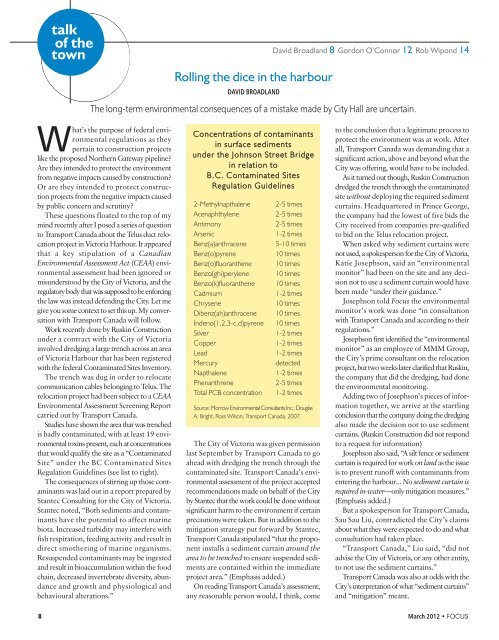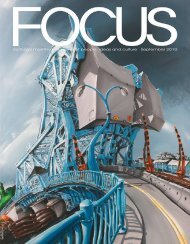Ger Lyons - Focus Magazine
Ger Lyons - Focus Magazine
Ger Lyons - Focus Magazine
You also want an ePaper? Increase the reach of your titles
YUMPU automatically turns print PDFs into web optimized ePapers that Google loves.
talk<br />
of the<br />
town<br />
What’s the purpose of federal environmental<br />
regulations as they<br />
pertain to construction projects<br />
like the proposed Northern Gateway pipeline?<br />
Are they intended to protect the environment<br />
from negative impacts caused by construction?<br />
Or are they intended to protect construction<br />
projects from the negative impacts caused<br />
by public concern and scrutiny?<br />
These questions floated to the top of my<br />
mind recently after I posed a series of question<br />
to Transport Canada about the Telus duct relocation<br />
project in Victoria Harbour. It appeared<br />
that a key stipulation of a Canadian<br />
Environmental Assessment Act (CEAA) environmental<br />
assessment had been ignored or<br />
misunderstood by the City of Victoria, and the<br />
regulatory body that was supposed to be enforcing<br />
the law was instead defending the City. Let me<br />
give you some context to set this up. My conversation<br />
with Transport Canada will follow.<br />
Work recently done by Ruskin Construction<br />
under a contract with the City of Victoria<br />
involved dredging a large trench across an area<br />
of Victoria Harbour that has been registered<br />
with the federal Contaminated Sites Inventory.<br />
The trench was dug in order to relocate<br />
communication cables belonging to Telus. The<br />
relocation project had been subject to a CEAA<br />
Environmental Assessment Screening Report<br />
carried out by Transport Canada.<br />
Studies have shown the area that was trenched<br />
is badly contaminated, with at least 19 environmental<br />
toxins present, each at concentrations<br />
that would qualify the site as a “Contaminated<br />
Site” under the BC Contaminated Sites<br />
Regulation Guidelines (see list to right).<br />
The consequences of stirring up those contaminants<br />
was laid out in a report prepared by<br />
Stantec Consulting for the City of Victoria.<br />
Stantec noted, “Both sediments and contaminants<br />
have the potential to affect marine<br />
biota. Increased turbidity may interfere with<br />
fish respiration, feeding activity and result in<br />
direct smothering of marine organisms.<br />
Resuspended contaminants may be ingested<br />
and result in bioaccumulation within the food<br />
chain, decreased invertebrate diversity, abundance<br />
and growth and physiological and<br />
behavioural alterations.”<br />
Rolling the dice in the harbour<br />
DAVID BROADLAND<br />
The City of Victoria was given permission<br />
last September by Transport Canada to go<br />
ahead with dredging the trench through the<br />
contaminated site. Transport Canada’s environmental<br />
assessment of the project accepted<br />
recommendations made on behalf of the City<br />
by Stantec that the work could be done without<br />
significant harm to the environment if certain<br />
precautions were taken. But in addition to the<br />
mitigation strategy put forward by Stantec,<br />
Transport Canada stipulated “that the proponent<br />
installs a sediment curtain around the<br />
area to be trenched to ensure suspended sediments<br />
are contained within the immediate<br />
project area.” (Emphasis added.)<br />
On reading Transport Canada’s assessment,<br />
any reasonable person would, I think, come<br />
David Broadland 8 Gordon O’Connor 12 Rob Wipond 14<br />
The long-term environmental consequences of a mistake made by City Hall are uncertain.<br />
Concentrations of contaminants<br />
in surface sediments<br />
under the Johnson Street Bridge<br />
in relation to<br />
B.C. Contaminated Sites<br />
Regulation Guidelines<br />
2-Methylnapthalene 2-5 times<br />
Acenaphthylene 2-5 times<br />
Antimony 2-5 times<br />
Arsenic 1-2 times<br />
Benz(a)anthracene 5-10 times<br />
Benz(o)pyrene 10 times<br />
Benz(o)fluoranthene 10 times<br />
Benzo(ghi)perylene 10 times<br />
Benzo(k)fluoranthene 10 times<br />
Cadmium 1-2 times<br />
Chrysene 10 times<br />
Dibenz(ah)anthracene 10 times<br />
Indeno(1,2,3-c,d)pyrene 10 times<br />
Silver 1-2 times<br />
Copper 1-2 times<br />
Lead 1-2 times<br />
Mercury detected<br />
Napthalene 1-2 times<br />
Phenanthrene 2-5 times<br />
Total PCB concentration 1-2 times<br />
Source: Morrow Environmental Consultants Inc.; Douglas<br />
A. Bright, Ross Wilson; Transport Canada, 2007.<br />
to the conclusion that a legitimate process to<br />
protect the environment was at work. After<br />
all, Transport Canada was demanding that a<br />
significant action, above and beyond what the<br />
City was offering, would have to be included.<br />
As it turned out though, Ruskin Construction<br />
dredged the trench through the contaminated<br />
site without deploying the required sediment<br />
curtains. Headquartered in Prince George,<br />
the company had the lowest of five bids the<br />
City received from companies pre-qualified<br />
to bid on the Telus relocation project.<br />
When asked why sediment curtains were<br />
not used, a spokesperson for the City of Victoria,<br />
Katie Josephson, said an “environmental<br />
monitor” had been on the site and any decision<br />
not to use a sediment curtain would have<br />
been made “under their guidance.”<br />
Josephson told <strong>Focus</strong> the environmental<br />
monitor’s work was done “in consultation<br />
with Transport Canada and according to their<br />
regulations.”<br />
Josephson first identified the “environmental<br />
monitor” as an employee of MMM Group,<br />
the City’s prime consultant on the relocation<br />
project, but two weeks later clarified that Ruskin,<br />
the company that did the dredging, had done<br />
the environmental monitoring.<br />
Adding two of Josephson’s pieces of information<br />
together, we arrive at the startling<br />
conclusion that the company doing the dredging<br />
also made the decision not to use sediment<br />
curtains. (Ruskin Construction did not respond<br />
to a request for information)<br />
Josephson also said, “A silt fence or sediment<br />
curtain is required for work on land as the issue<br />
is to prevent runoff with contaminants from<br />
entering the harbour... No sediment curtain is<br />
required in-water—only mitigation measures.”<br />
(Emphasis added.)<br />
But a spokesperson for Transport Canada,<br />
Sau Sau Liu, contradicted the City’s claims<br />
about what they were expected to do and what<br />
consultation had taken place.<br />
“Transport Canada,” Liu said, “did not<br />
advise the City of Victoria, or any other entity,<br />
to not use the sediment curtains.”<br />
Transport Canada was also at odds with the<br />
City’s interpretation of what “sediment curtains”<br />
and “mitigation” meant.<br />
8 March 2012 • FOCUS

















